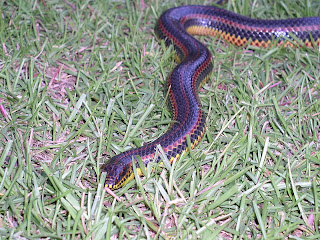Farancia is a genus of colubrid snakes. It consists of two species, one commonly referred to as the rainbow snake and the other commonly referred to as the mud snake. They are native to the eastern half of the United States.
Description
Farancia species can grow to a length of 30-54 inches. They are usually uniform dark brown or black with a brightly colored underside that is red or orange. Rainbow snakes exhibit red striping down their back.
Behaviour
The snakes of this genus are typically semi-aquatic. Living in the muddy edges of slow moving, permanent water sources. Their diet consists primarily of amphiumas, eels, and sirens. Breeding occurs in early spring, and eggs are laid in a burrow near the water in early summer. The clutch incubates between 8–12 weeks, and hatches in mid-autumn.
Species
Farancia abacura - Texas, Arkansas, Louisiana, Mississippi, Alabama, Georgia, Florida, North and South Carolina, Virginia, Tennessee, Missouri, Illinois, and Kentucky.
Eastern Mud Snake, Farancia abacura abacura (Holbrook, 1836)
Western Mud Snake, Farancia abacura reinwardtii (Schlegel, 1837)
Farancia erytrogramma - Louisiana, Mississippi, Alabama, Georgia, Florida, North and South Carolina, Virginia, and Maryland.
Rainbow Snake, Farancia erytrogramma erytrogramma (Palisot de Beauvois, 1802)
Florida Rainbow Snake, Farancia erytrogramma seminola (Neill, 1964)
Geographic range
The mud snake is found primarily in the southeastern United States, in the states of Texas, Arkansas, Oklahoma, Louisiana, Mississippi, Alabama, Georgia, Florida, North and South Carolina, Virginia, Tennessee, Missouri, Illinois, and Kentucky.
Cultural Significance
The mud snake is one of a few animals which may be the origin of the hoop snake myth. J.D. Wilson Writes:
“ Mud snakes are sometimes known as “hoop snakes” because of the myth that they will bite their own tail and roll after people.[1] ”
The hoop snake myth has also been attributed to the Coachwhip snake.
Description
Farancia species can grow to a length of 30-54 inches. They are usually uniform dark brown or black with a brightly colored underside that is red or orange. Rainbow snakes exhibit red striping down their back.
Behaviour
The snakes of this genus are typically semi-aquatic. Living in the muddy edges of slow moving, permanent water sources. Their diet consists primarily of amphiumas, eels, and sirens. Breeding occurs in early spring, and eggs are laid in a burrow near the water in early summer. The clutch incubates between 8–12 weeks, and hatches in mid-autumn.
Species
Farancia abacura - Texas, Arkansas, Louisiana, Mississippi, Alabama, Georgia, Florida, North and South Carolina, Virginia, Tennessee, Missouri, Illinois, and Kentucky.
Eastern Mud Snake, Farancia abacura abacura (Holbrook, 1836)
Western Mud Snake, Farancia abacura reinwardtii (Schlegel, 1837)
Farancia erytrogramma - Louisiana, Mississippi, Alabama, Georgia, Florida, North and South Carolina, Virginia, and Maryland.
Rainbow Snake, Farancia erytrogramma erytrogramma (Palisot de Beauvois, 1802)
Florida Rainbow Snake, Farancia erytrogramma seminola (Neill, 1964)
Geographic range
The mud snake is found primarily in the southeastern United States, in the states of Texas, Arkansas, Oklahoma, Louisiana, Mississippi, Alabama, Georgia, Florida, North and South Carolina, Virginia, Tennessee, Missouri, Illinois, and Kentucky.
Cultural Significance
The mud snake is one of a few animals which may be the origin of the hoop snake myth. J.D. Wilson Writes:
“ Mud snakes are sometimes known as “hoop snakes” because of the myth that they will bite their own tail and roll after people.[1] ”
The hoop snake myth has also been attributed to the Coachwhip snake.














